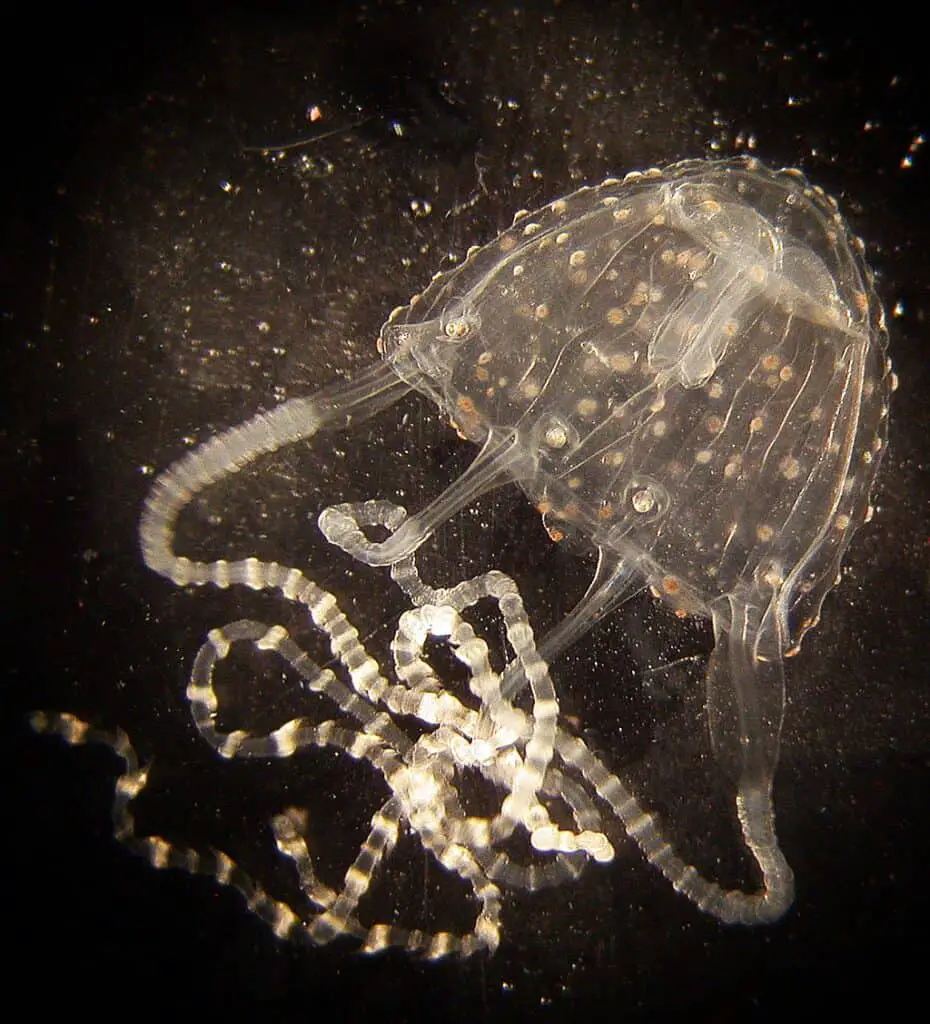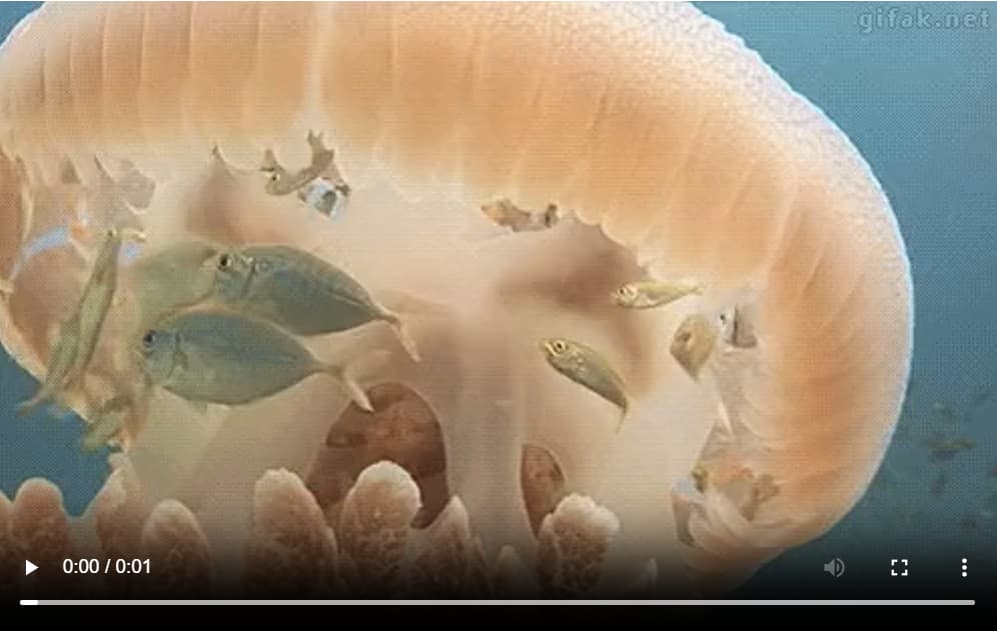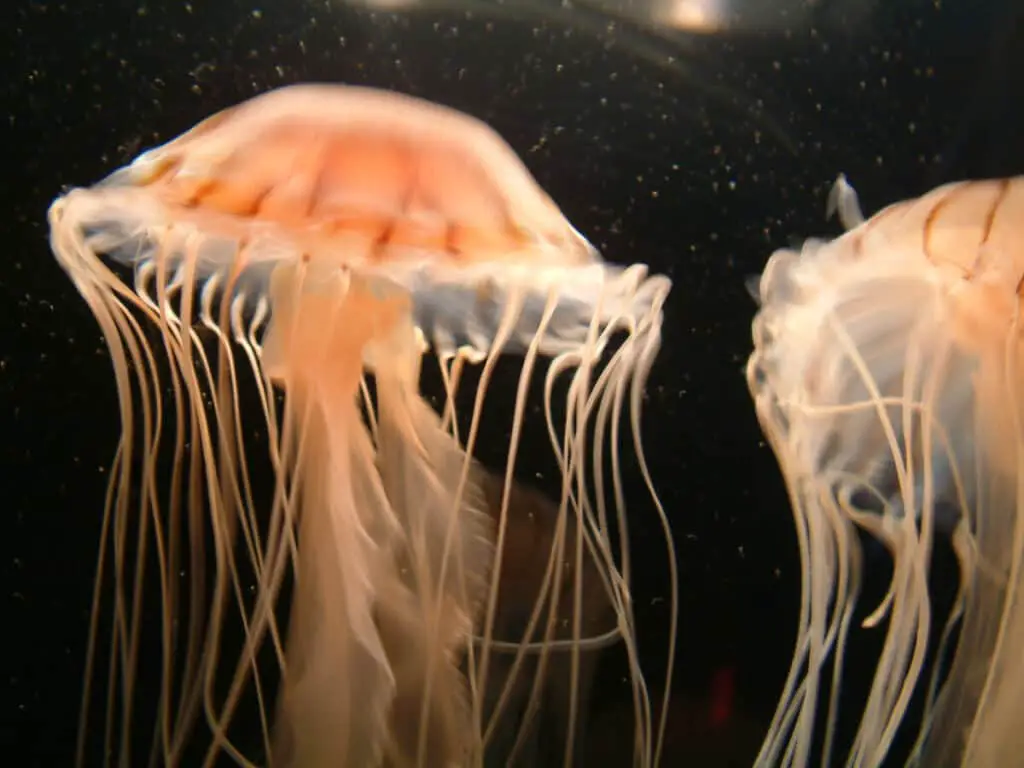As a biologist, I’m fascinated with one of the most successful creatures on our planet – the jellyfish. Let’s take a closer look at how they manage to survive… even when it seems they do not have a lot going for them!!
Jellyfish do NOT have brains (or bones, teeth, blood…or even hearts). Instead, they have nets of neurons and specialized sensory structures along the edge of their bells called “rhopalia.” Using their senses, jellyfish can discern light from dark, up from down. Some species, such as box jellyfish, actively hunt and kill their prey without having a brain!
Jellyfish have lived in the oceans for at least 500 million years and possibly more than 700 MY – long before the emergence of fish, trees, or flowering plants. They are remarkably well-adapted for the conditions they face and have survived as the oldest group of multi-organ animals on the planet.
I think you may be surprised to learn how complex these seemingly simple creatures really are. Even though they consist of about 95 percent water, they manage very well without a brain!!
How to Succeed Without a Brain
Jellies are not just aimless drifters! They have complex nervous systems
Even though jellyfish don’t have brains per se, we can see that they do have surprisingly complex nervous systems. Using these three components of their nervous systems – rhopalia, the large net and the small net – jellyfish have mastered their environment and developed the means to thrive and survive in the oceans.
Jellyfish don’t just swim aimlessly—some species can navigate, using the small net to coordinate refined activities, such as hunting and feeding.
For example, box jellyfish have advanced eyes similar to those of humans. Their complicated eyes allow them to actively hunt and seek favorable habitats. According to a recent Current Biology study. “These behaviors require not only accurate vision but also precise control of speed and direction of swimming,” write the researchers.
“The box jellyfish solution may thus be linked to the absence of a central brain, but it defeats the idea that a central brain is a prerequisite for advanced behavior,” write the researchers.

TINY and DEADLY! Irukandji box jellies have amazing technique for attracting fish with lures and then killing them with some of the most powerful venoms on earth!
Check out my article on Irukandji jellyfish to learn more!
Jellyfish have a decentralized nervous system
Instead of a single, centralized brain, jellies have neurons throughout their body that act like a net of nerves. Rather than connecting to one central brain, neurons in the net interconnect with each other without any apparent sort of hierarchy or some being more important than others.
The rhopalia are spread evenly along the lower edge of the bell and together they “act like a pacemaker,” writes Rebecca Helm, jelly biologist with the University of North Carolina, “helping coordinate jelly movement, similar to the way our cerebellum coordinates ours.”

In addition to the neurons in the rhopalia, the rest of the nervous system is broken into two parts or neural nets; a “Large Nerve Net” and a “Small Nerve Net.”
The Large Nerve Net
Why is this nerve net considered large? Turns out that the nerve cells that compose this net are large – literally huge! The reason is that, unlike many animals, including mammals like us, jellyfish don’t have a specialized kind of fatty cell called oligodendrocytes. These specialized fatty cells wrap around the neurons, like wire insulation, making the nerves better conductors. Consequently, even thin human neurons can transmit massive amounts of information.
Since jellyfish nerves don’t have fatty insulating cells their neurons have to be huge to conduct the required amount of information quickly.
The Large Nerve Net ties directly into the muscle layer found along the underside of jellyfish, coordinating the rhythmic pulsing of these muscles. When we see a jellyfish pulsing through the water, we’re watching the Large Nerve Net turn the entire jellyfish into a big beating heart.
The Small Nerve Net
The second nerve net is the “Small Nerve Net.” This nerve net coordinates all the non-swimming behaviors, which can be more demanding than the rhythmic pulsing actions. One example is feeding behavior, where the jellyfish sucks the food from the tentacle that has managed to capture prey.
How can the jelly “know” which tentacle has food without a brain?!
Somehow the small nerve net helps the jelly differentiate between the various parts of its body and to coordinate movements and tasks between them.

How can jellyfish survive without a brain?
When you think of all the organisms on our planet, we see incredible diversity all around us. The creatures that we see are the ones that are best adapted to conditions on earth as we know it today. It is sobering to think that 99% of all the creatures that have ever lived are now extinct. Millions and millions of species have gone extinct during the period that jellyfish have survived.
Jellyfish have managed to thrive in our oceans for hundreds of millions of years because they have what it takes to pass on their genes from one generation to the next. And they manage to do very well without having a brain.
In general, jellyfish can discern light from dark, and up from down using “rhopalia” – the specialized sensory structures along the edge of their bells. Rhopalia combine some of the functions of our eyes, middle ears, and cerebellum all in one place…and perhaps even our sense of smell.
Brains require a lot of resources, biologically speaking, so an animal that can thrive without a brain is perfectly fit from an evolutionary standpoint.
How can that be? The word “fit” can easily throw a lot of people. That’s because we’ve all heard the phrase “survival of the fittest” and we automatically think of some big tough guy winning over some puny weakling. But that’s not what fittest means in evolutionary terms.
Fitness – in evolutionary terms – means that an organism is well-fitted to survive in its current environment, with all the challenges and opportunities entailed. If an organism can continue to do well as the environment around it changes, it will continue to survive and pass on its genes. If not, it will go extinct.
Jellyfish have demonstrated remarkable resilience in adapting to changes in the environment over many, many millions of years.

In Summary
Jellyfish may not have a centralized brain, but they do have a complex and effective nervous system:
- One part of the nervous system, that includes the rhopalia, forms a ring where the neurons are concentrated to process sensory and motor activity.
- “Large Net” neurons send chemical signals to the muscles to rhythmically contract, allowing the animals to swim.
- “Small Net” neurons help to coordinate more specialized behaviors and activities, such as hunting and feeding.
When it comes to jellyfish, there are lots more questions than answers!
I aim to delve further into fascinating jellyfish behavior and biology in future posts!
What do jellies feed on if they don’t have teeth?
Do they have a circulatory system?
How do they get rid of waste?
References
Katsuki, T, Greenspan, RJ. Jellyfish Nervous Systems: Quick Guide GUIDE| Current Biology. Vol 23, Issue 14, PR592-R594, JULY 22, 2013. https://doi.org/10.1016/j.cub.2013.03.057
Satterlie RA, Eichinger JM. Organization of the ectodermal nervous structures in jellyfish: scyphomedusae. Biol Bull. 2014 Feb;226(1):29-40. doi: 10.1086/BBLv226n1p29. PMID: 24648205.
The Gear We Love to Travel With
We love to travel in search of exceptional wildlife viewing opportunities and for life-enhancing cultural experiences.
Here is the gear we love to travel with for recording our adventures in safety and comfort:
- Action Camera: GoPro Hero10 Black – we find these waterproof cameras are invaluable for capturing the essence of our adventures in video format. Still photos are great, but video sequences with all the sights and sounds add an extra dimension. I use short video clips to spice up many of my audiovisual presentations.
- Long Zoom Camera: Panasonic LUMIX FZ300 Long Zoom Digital Camera – I love this camera for its versatility. It goes from wide angle to 28X optical in a relatively compact design. On safari in Africa I’ve managed to get good shots of lions that the folks with long lenses kept missing – because the lions were too close! I also like the 120 fps slow-motion for action shots of birds flying and animals on the move. I call this my “bird camera.”
- 360 Camera: Insta360 ONE R 360 – 5.7K 360 Degree Camera, Stabilization, Waterproof – see my article How to Take Impossible Shots with Your 360 Camera. This camera is literally like taking your own camera crew with you when you travel! Read my article and you’ll see why.
- Backpack camera mount: Peak Design Capture Clip
- Drone: DJI Mini 2 (Fly More Combo) – this mini drone is made for travel!
- Water Filtration: LifeStraw Go Water Filter Bottle
- Binoculars: Vortex Binoculars or Vortex Optics Diamondback HD Binoculars (good price)
Check Out Our TOP Articles for Even More Fascinating Creatures
- How do Octopus Reproduce? (Cannibalistic Sex, Detachable Penis)
- Do Jellyfish have Brains? How Can they Hunt without Brains?
- Why are Deep Sea Fish So Weird and Ugly? Warning: Scary Pictures!
- Are Komodo Dragons Dangerous? Where Can you See Them?
- Koala Brains – Why Being Dumb Can Be Smart (Natural Selection)
- Why do Lions Have Manes? (Do Dark Manes Mean More Sex?)
- How Do Lions Communicate? (Why Do Lions Roar?)
- How Dangerous are Stonefish? Can You Die if You Step on One?
- What Do Animals Do When They Hibernate? How do they Survive?
- Leaf Cutter Ants – Surprising Facts and Adaptations; Pictures and Videos
- Irukandji Jellyfish Facts and Adaptations; Can They Kill You? Are they spreading?
- How to See MORE Wildlife in the Amazon: 10 Practical Tips
- Is it Safe to go on Safari with Africa’s Top Predators and Most Dangerous Animals?
- What to Do if You Encounter a Bullet Ant? World’s Most Painful Stinging Insect!
- How Do Anglerfish Mate? Endless Sex or Die Trying!
- How Smart are Crocodiles? Can They Cooperate, Communicate…Use Tools?
- How Can We Save Our Oceans? With Marine Sanctuaries!
- Why Are Male Birds More Colorful? Ins and Outs of Sexual Selection Made Easy!
- Why is the Cassowary the Most Dangerous Bird in the World? 10 Facts
- How Do African Elephants Create Their Own Habitat?
- What is Killing Our Resident Orcas? Endangered Killer Whales
- Why are Animals of the Galapagos Islands Unique?
- Where Can You See Wild Lemurs in Madagascar? One of the Best Places
- Where Can You see Lyrebirds in the Wild? the Blue Mountains, Australia
- Keeping Mason Bees as Pets
- Why do Flamingos have Bent Beaks and Feed Upside Down?
- Why are Hippos Dangerous? Why Do They Kill People?


